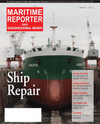
Page 63: of Maritime Reporter Magazine (March 2012)
The Ship Repair Edition
Read this page in Pdf, Flash or Html5 edition of March 2012 Maritime Reporter Magazine
March 2012 www.marinelink.com 63Far Left: Edward Lundquist, U.S. Navy (Retired) and Jason Story, U.S. Coast Guard, examine a weld sam- ple as John Alt, UNO-NCAM, explains the weld tech-nique.At the Universal Weld System #1 (UWS1), visitors watch video samples of the weld system in action.UNO-NCAM hosted a tour of NCAM for attendees ofthe Titanium Ship Structure Summit held in New Or- leans Nov. 7-9. On the UWS1, L to R: Greg Dobson, Bruce Brailsford, UNO-NCAM; Edward Lundquist, U.S. Navy (Retired) & Contributing Editor of MarineLink.com; Captain Charles Gunzel, U.S. Navy;Lawrence DeCan, UNO; Nicholas Weinhold, U.S. Navy Carderock Division; Erasto Fernandez, UNO; John Pyle, Jeff Bernath, RTI International Metals; Jason Story, U.S. Coast Guard. Titanium Welding &Fabrication Facility Titanium is not new, even for naval ship structures. Aircraft components have been made from Ti for many years because it is stronger and lighter. Several So- viet submarines were built largely of titanium. The U.S. Navy continues to gain experience with Ti, as well. The Puget Sound Naval Shipyard and Intermediate Maintenance Facility's (PSNS & IMF) in Bre- merton, Wash., established a titanium welding and fabrication facility in 2011. While the Puget Sound yard has more than 400 qualified welders, only 10 are qualified as titanium welders. The new titanium welding facility will help to main- tain quality on every job by controlling the temperature and humidity in the work area, and segregating those tools used only on titanium. "Welding and fabricating titanium requires additional controls, but is not much more difficult than working with other materials," says PSNS & IMF welding engineer Chris Melvin, PSNS & IMF. Working with titanium requires strict attention to temperature and a clean work area and employment of an ?auxiliary? inert gas to prevent contamination by air while welding. The air we breathe contains elements such as carbon, nitrogen, hydrogen and oxygen, all of which can cause the material to lose its desired prop- erties. "The value to the Navy by using titanium piping systems over copper nickel or other materials is that the titanium systems are designed to last for the life of theship or submarine instead of being replaced two or three times," says Melvin. "The initial cost of using titanium is higher, but the value is the material's strength and high resistance to cracking and seawater corrosion." "One way the new facility helps us prevent impurities is by purging the part of pipe to be welded with weld gas, internally and externally," said Melvin. "Spe- cialized equipment of the facility maintains weld quality by using a purge con- tainment glove box that controls and maintains an atmosphere of inert gas to prevent impurity entrapment during welding." MR March 12 # 8 (56-64):MR Template 3/2/2012 8:42 AM Page 63

 62
62

 64
64
